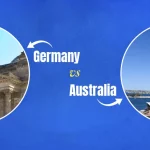Canada vs Australia: Which Country is Better for International Students in 2025?
Table of Contents
When it comes to choosing a study destination, Canada and Australia are two of the most sought-after countries for international students. Both nations offer top-tier education, welcoming multicultural environments, and outstanding career opportunities after graduation. However, deciding between the two requires careful consideration of various factors, including tuition fees, cost of living, university rankings, and post-study work options.
Canada is renowned for its affordability, inclusive immigration policies, and globally recognized degrees. It’s an ideal destination for students seeking a balance between academic rigor and cultural diversity. On the other hand, Australia stands out for its innovative teaching methods, excellent research, and a vibrant lifestyle. Both countries have their unique strengths, but the right choice depends on your personal goals and preferences.
In this blog, we’ll explore the critical aspects of studying in Canada vs. Australia, comparing key elements like cost of living, top universities, popular courses, and visa opportunities. Let’s find out!
Canada vs. Australia: Country Highlights
Choosing between Canada and Australia involves understanding their economic, cultural, and academic landscapes. Both countries offer excellent opportunities, but their unique characteristics may appeal to different types of students. Here’s what makes each country stand out:
| Aspect | Canada | Australia |
| Capital | Ottawa | Canberra |
| Currency | Canadian Dollar (CAD) | Australian Dollar (AUD) |
| Cost of Living | Moderate; varies by city (Toronto and Vancouver are more expensive than smaller cities like Halifax) | Generally high; Sydney and Melbourne are pricier than cities like Adelaide and Perth |
| Popular Jobs | Software Engineer, Data Scientist, Medical Professionals, HR Manager, Marketing Manager | Construction Manager, Teacher, Healthcare, Mining Engineer, Information Technology |
| Work Opportunities | Post-Graduation Work Permit (up to 3 years, leading to PR pathways) | Temporary Graduate Visa (up to 6 years for regional areas, with pathways to PR) |
| Visa Policies | Clear pathways to Permanent Residency for graduates with Canadian work experience | Multiple visa schemes offering pathways to Permanent Residency based on qualifications and work |
Popular Courses in Canada vs. Australia (2025)
Choosing the right course is as important as selecting the right country. Both Canada and Australia offer a wide variety of programs, but they have their own areas of expertise. Following are the most popular courses in both Canada and Australia to help you make an informed decision:
| Popular courses to Study in Canada | Annual Tuition Fee (INR) | Popular courses to Study in Australia | Annual Tuition Fee |
| Business & Management | 18 Lakhs | Architecture | 19 Lakhs |
| Engineering | 21 Lakhs | Biomedical Engineering | 22 Lakhs |
| Medicine | 20 Lakhs | Accountancy | 16 Lakhs |
| Pharmacy | 25 Lakhs | Earth Sciences | 25 Lakhs |
| Dentistry | 35 Lakhs | Information Technology | 25 Lakhs |
Top Universities: Canada vs Australia (QS World University Rankings 2025)
As an Indian student, deciding between Canada and Australia means choosing between two countries with some of the world’s top universities. Both offer exceptional opportunities for education, personal growth, and career development.
Canada is home to prestigious institutions like the University of Toronto (ranked 25th globally) and the University of British Columbia (38th), known for their strong research, innovative teaching, and multicultural campuses. These universities create a supportive and enriching environment for international students.
In comparison, Australia boasts globally acclaimed universities like the University of Melbourne (13th), the University of Sydney (18th), and the University of New South Wales (UNSW) (19th). These institutions are famous for their cutting-edge research, strong industry connections, and focus on practical learning.
Both destinations excel in providing world-class education—your choice depends on which aligns best with your academic and career goals. Following table showcases the top universities in Canada and Australia according to the QS World University Rankings 2025:
Here’s a combined table showcasing the top universities in Canada and Australia according to the QS World University Rankings 2025:
| Country | University Name | QS World University Rankings 2025 |
| Canada | University of Toronto | #25 |
| Canada | McGill University | #29 |
| Canada | University of British Columbia | #38 |
| Canada | University of Alberta | #96 |
| Canada | University of Waterloo | #115 |
| Australia | University of Melbourne | #13 |
| Australia | University of Sydney | #18 |
| Australia | University of New South Wales (UNSW) | #19 |
| Australia | Australian National University (ANU) | #30 |
| Australia | Monash University | #37 |
Read more: Cost of Living in Canada
Cost of Living: Canada vs. Australia
Studying abroad involves more than just tuition fees; understanding the cost of living in your destination country is essential for effective budgeting. Both Canada and Australia offer unique advantages, but their everyday expenses differ significantly. Here’s a breakdown of the monthly cost of living in each country to help you plan your overall budget:
| Expense Type | Australia (AUD) | Approx. INR | Canada (CAD) | Approx. INR |
| Hostels | 330 – 570 AUD | 18,000 – 31,000 | 290 – 600 CAD | 18,000 – 37,000 |
| Shared Rental | 370 – 830 AUD | 20,000 – 45,000 | 240 – 570 CAD | 15,000 – 43,000 |
| Private Rental | 720 – 1,700 AUD | 39,000 – 92,000 | 400 – 1,500 CAD | 25,000 – 92,000 |
| Internet/Phone | 20 – 50 AUD | 1,000 – 3,000 | 50 – 90 CAD | 3,000 – 5,000 |
| Food | 70 – 300 AUD | 4,000 – 16,000 | 1,250 – 1,550 CAD | 74,000 – 92,000 |
| Electricity/Gas | 20 – 140 AUD | 1,000 – 7,000 | 200 CAD | 12,000 |
| Transport | 20 – 50 AUD | 1,000 – 3,000 | 100 – 150 CAD | 6,000 – 9,000 |
Points to be noted:
- Accommodation: Both countries offer a range of housing options. While hostel and shared rental costs are comparable, private rentals in Canada can be slightly more affordable depending on the city.
- Utilities and Internet: Australia offers more economical options for electricity and phone services, whereas Canada’s costs tend to be higher, particularly for internet.
- Food and Groceries: Food expenses in Canada are generally higher, especially if you plan to eat out frequently. Australia offers more affordable options for groceries and dining.
- Transportation: Public transport costs are higher in Canada, but both countries provide student discounts to make commuting easier.
Cost of Studying: Canada vs Australia – Tuition Fees Comparison
When deciding where to study abroad, one of the most important considerations is the cost of education. Tuition fees are a significant part of this, and understanding the financial requirements of each country is essential. Canada and Australia are both top destinations for international students, but their tuition structures differ notably. Following are the course vise details of Tuition fees in Canada and Australia:
| Study Level | Canada | Australia |
| Undergraduate Degree | CAD 15,000 – CAD 54,000 (INR 9L – INR 32L) | AUD 20,000 – AUD 45,000 (INR 11L – INR 25L) |
| Postgraduate Degree | CAD 13,000 – CAD 45,000 (INR 8L – INR 27L) | AUD 22,000 – AUD 50,000 (INR 12L – INR 28L) |
| MBA Programs | CAD 34,000 (INR 20L) | AUD 18,000 – AUD 41,000 (INR 10L – INR 23L) |
Conclusion
Deciding between Canada and Australia for your studies depends on your goals and priorities. Canada offers a more affordable living experience, inclusive immigration pathways, and a supportive multicultural environment. On the other hand, Australia excels with its globally ranked universities, extensive work opportunities, and vibrant lifestyle.
Ultimately, both countries provide exceptional opportunities for academic and personal growth. Take time to evaluate your aspirations, finances, and career plans to choose the destination that best aligns with your future goals.
Frequently Asked Questions
How do tuition fees compare between Canada and Australia for international students?
Tuition fees in both countries vary based on the institution and program. In Canada, tuition fees of international undergraduate students can expect to pay between CAD 29,000 and CAD 81,000 annually. In Australia, fees range from AUD 26,500 to AUD 113,000 per year. It's important to research specific programs and universities to determine exact costs.
What are the living expenses in Canada compared to Australia?
Living costs depend on the city and lifestyle. Generally, Canada offers a more affordable living budget, with average monthly expenses between USD 800 and USD 1,000. In contrast, Australia’s living expenses are higher, averaging up to USD 1,200 per month. These figures can vary, so it's advisable to budget according to your chosen location.
Which course is most popular in Canada?
Canada offers a range of in-demand courses across various fields, including Engineering, Information Technology (IT) and Computer Science, Business Administration, Health Sciences, Finance and Accounting, Media and Communication, and Applied Sciences and Technology.
Is salary in Australia better than Canada?
In Canada, the average annual salary is approximately CAD 70,000, equating to CAD 35.90 per hour. The minimum wage, which varies by province, was raised to a federal rate of CAD 16.65 per hour as of April 2023. In Australia, the national minimum wage stands at AUD 21.38 per hour or AUD 812.60 per week, reflecting the country’s commitment to fair compensation for workers.







